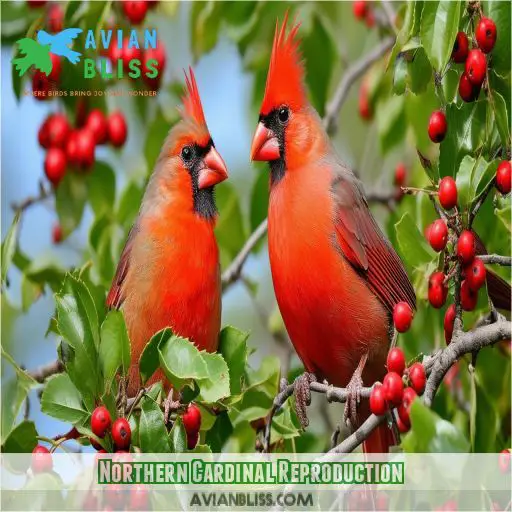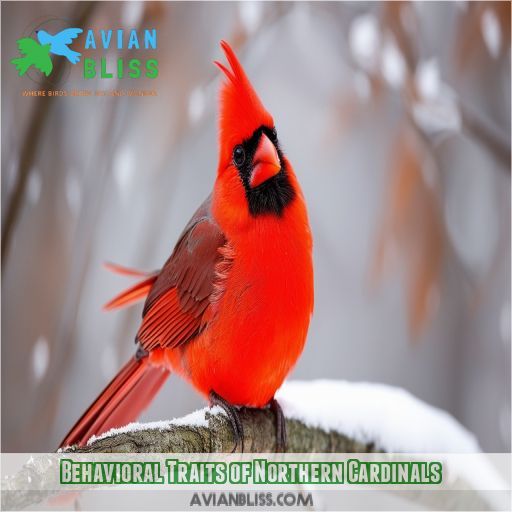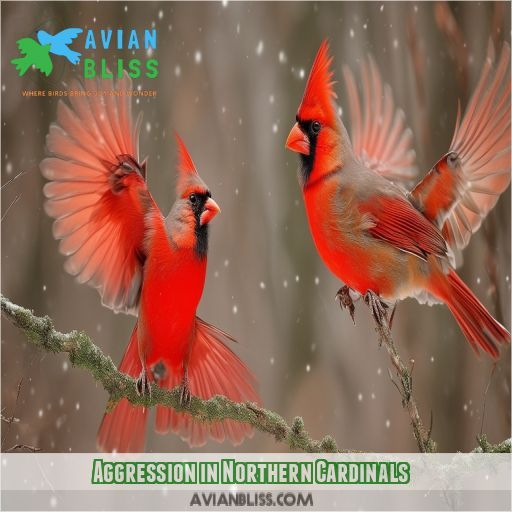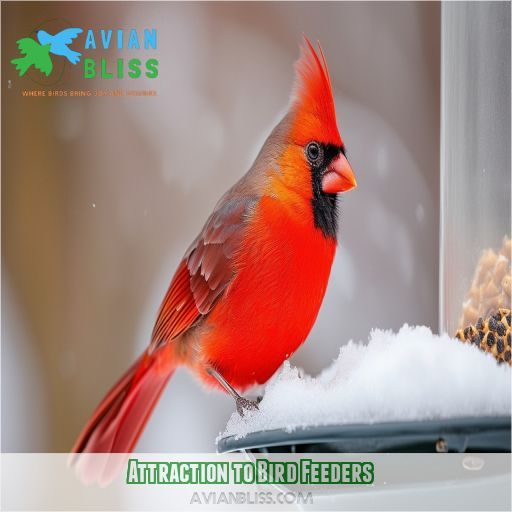This site is supported by our readers. We may earn a commission, at no cost to you, if you purchase through links.

Known for their striking red plumage and territorial nature, these birds are a common sight in backyards and gardens across the eastern and central regions of the continent.
With a medium build, distinctive crests, and loud, clear whistles, they’re hard to miss.
But there’s more to these birds than meets the eye. As you’ll see, their behavior, reproduction, and conservation status make them fascinating creatures.
Table Of Contents
- Key Takeaways
- Physical Characteristics of Northern Cardinals
- Habitat and Range of Northern Cardinals
- Northern Cardinal Reproduction
- Lifespan and Longevity of Northern Cardinals
- Behavioral Traits of Northern Cardinals
- Communication in Northern Cardinals
- Predators of Northern Cardinals
- Aggression in Northern Cardinals
- Attraction to Bird Feeders
- Conservation Status and Cultural Significance
- Frequently Asked Questions (FAQs)
- What are the characteristics of the Northern Cardinal?
- What is the difference between a cardinal and a Northern Cardinal?
- What are the main predators of the Northern Cardinal?
- Are northern cardinals aggressive?
- What is the Northern Cardinals scientific name?
- Are Northern Cardinals native to Canada?
- What do Northern Cardinals eat?
- Are Northern Cardinals social birds?
- How many types of Northern Cardinals are there?
- Conclusion
Key Takeaways
- These birds are like feathered celebrities: With their vibrant red plumage and distinctive crests, Northern Cardinals are hard to miss. They are the stars of many backyard bird-watching sessions.
- It’s not just about their looks: Northern Cardinals are fierce defenders of their territory, especially during the nesting season. They’ll challenge their own reflections, believing it to be a rival bird trying to take over their space.
- Ever-present like the Energizer Bunny: Being non-migratory, Northern Cardinals are year-long residents. You can enjoy their lively songs and colorful presence regardless of the season.
- Adaptable survivors: Northern Cardinals have expanded their range northward and westward in recent decades. They are not afraid to explore new habitats and adapt to changing environments.
Physical Characteristics of Northern Cardinals
You’ll easily recognize the Northern Cardinal by its distinctive bright red plumage and prominent crest, which are hallmarks of the male of the species. The females, while less vibrant, display a warm brown coloration with reddish accents, showcasing the sexual dimorphism that’s characteristic of this popular songbird.
Plumage and Crest
You’ll instantly recognize a Northern Cardinal by its vibrant plumage and distinctive crest. This year-round backyard visitor sports a sharp, pointed crest atop its head, giving it a regal appearance. The crest can be raised or lowered, reflecting the bird’s mood. Cardinals’ feathers are dense and sleek, providing excellent insulation. Their beaks are cone-shaped and powerful, perfect for cracking seeds.
Key features of Northern Cardinal plumage:
- Bright red coloration in males
- Black face mask surrounding the bill
- Thick, sturdy legs and feet
- Long tail feathers for balance
These non-migratory birds maintain their striking appearance throughout the year, making them a constant delight for bird enthusiasts in their range.
Sexual Dimorphism
You’ll notice striking sexual dimorphism in Northern Cardinals. The males sport vibrant red plumage with a black mask, while females boast a more subdued brown coloration with reddish accents. This color contrast isn’t just for show; it’s deeply rooted in evolutionary advantages and mating strategies.
| Feature | Male Cardinals | Female Cardinals |
|---|---|---|
| Plumage | Bright red | Brown with red accents |
| Mask | Black | None |
| Bill | Red-orange | Pink-orange |
| Crest | Prominent | Less pronounced |
| Tail | Long, red | Long, brown |
Hormonal influences play a pivotal role in this feather structure difference. The male’s flashy appearance aids in attracting mates, while the female’s understated look provides camouflage during nesting. This clever adaptation ensures the species’ survival, balancing attraction and protection.
Habitat and Range of Northern Cardinals
You’ll find Northern Cardinals across a wide swath of North America, from southeastern Canada to the southern United States and parts of Mexico. These adaptable birds thrive in various habitats, including open woodlands, suburban gardens, and desert washes, showing a preference for areas with dense vegetation and readily available food sources.
Geographic Distribution
You’ll find Northern Cardinals across a vast swath of Eastern North America, from Southeastern Canada down to the Gulf Coast. These vibrant songbirds have been expanding their range northward and westward for decades, partly due to climate change and suburban sprawl. They’ve even been introduced to Hawaii, Southern California, and Bermuda.
While they’re thriving in many areas, habitat preservation remains vital for their continued success. Conservation measures are helping to protect their diverse habitats, from woodlands to urban parks.
As you explore the Eastern United States, keep an eye out for these scarlet beauties – they’re not just surviving, but flourishing in our changing landscape.
Preferred Habitats
You’ll find Northern Cardinals thriving in a variety of habitats, from dense undergrowth to suburban backyards. These adaptable birds prefer forest edges, where they can flit between open areas and protective cover. During breeding season, they’re particularly fond of thick tangles and shrubs for nesting.
As their range expands northward, they’ve become fixtures in suburban areas, where they’re drawn to bird feeders and landscaped gardens. While native to North America, they’ve become invasive species in some regions. Their year-round presence means you can spot them in Central America, too.
Cardinals’ ability to thrive in human-altered landscapes has contributed to their success, making them familiar faces from city parks to rural woodlands.
Northern Cardinal Reproduction
You’ll find Northern Cardinals nesting in dense vegetation, typically 3-10 feet above ground, with the female constructing a cup-shaped nest of twigs, bark strips, and grasses. Both parents contribute to caring for their young, with the male often feeding the female while she incubates the eggs and both adults sharing the responsibility of feeding the nestlings once they hatch.
Nesting Habits
You’ll find Northern Cardinals’ nests tucked away in dense vegetation, usually 3-10 feet above ground. These skilled architects craft their homes from twigs, bark strips, and grass, lining them with softer materials.
The female takes charge, spending 8-13 days building the nest while her mate stands guard. She’ll lay 2-5 eggs, which she’ll incubate for about 12 days.
During this time, the male’s vibrant red plumage serves as a decoy, drawing predators away from the nest. Both parents fiercely defend their territory, with the male often engaging in aggressive displays to ward off intruders.
This dedication guarantees their chicks have the best start in life.
Parental Care
Once the nest is built, you’ll witness devoted parental care from Northern Cardinals. Both parents work tirelessly to protect their precious offspring from predators. The male stands guard, fiercely defending against intruders, while the female incubates the eggs.
After hatching, you’ll see them tag-teaming to feed their hungry nestlings. They’ll bring a variety of seeds, insects, and berries to nourish their growing chicks.
As the hatchlings develop, you might spot the parents teaching them essential skills like foraging at bird feeders. Even after fledging, the devoted duo continues to care for their young, gradually guiding them into independence in a world full of challenges.
Lifespan and Longevity of Northern Cardinals
You’ll be fascinated to learn about the Northern Cardinal’s impressive lifespan. These vibrant songbirds can live up to 15 years in the wild, with the oldest recorded individual reaching 15 years and 9 months. While their average life expectancy is around 3 years, cardinals often outlive many other backyard birds. Here are some factors that contribute to their longevity:
- Adaptability to various habitats
- Year-round presence in their range
- Ability to utilize bird feeders for supplemental food
While a cardinal’s average lifespan is 3-5 years, understanding their mating habits, including their tendency to form lasting monogamous bonds, helps you appreciate these territorial birds’ resilience and their enduring presence in your backyard.
Behavioral Traits of Northern Cardinals
You’ll observe Northern Cardinals exhibiting distinct foraging behaviors, often searching for seeds and insects on the ground or in low vegetation. These vibrant birds are also fiercely territorial, with males aggressively defending their nesting areas from intruders, especially during the breeding season.
Foraging Behavior
As you observe Northern Cardinals, you’ll notice their unique foraging behavior. These vibrant birds are primarily ground foragers, but they’re adaptable feeders. Here’s a breakdown of their foraging strategies:
| Location | Food Type | Technique |
|---|---|---|
| Ground | Seeds | Hopping |
| Shrubs | Insects | Gleaning |
| Feeders | Sunflower | Perching |
Cardinals aren’t picky eaters. They’ll happily munch on seeds, especially sunflower seeds from bird feeders. But don’t be fooled by their seed-loving reputation; they’ve got a taste for insects too. During breeding season, you’ll catch them snatching up caterpillars and beetles to feed their hungry chicks. Their strong, cone-shaped bills are perfect for cracking open seeds and nabbing insects.
Territoriality
As you observe Northern Cardinals foraging, you’ll notice their territorial nature. These vibrant songbirds, measuring 8-9 inches and weighing 1½ to 1⅔ ounces, fiercely defend their turf. Both male and female cardinals sing to establish boundaries, creating a melodious conclave behavior.
Their aggression triggers include intruders and, surprisingly, their own reflections. You’ll often spot them attacking mirrors or windows, mistaking their image for a rival.
Population density influences territoriality, with cardinals adjusting their space based on resources. While they’re protective of their domain, you can still attract them to your yard with bird feeders stocked with their favorite seeds.
Communication in Northern Cardinals
You’ll find that Northern Cardinals have a rich vocal repertoire, with both males and females capable of producing sweet, clear whistles and chip calls. Their songs consist of down-slurred whistles, and pairs often engage in duets during courtship and nesting, showcasing the unique communication dynamics of this vibrant species.
Song Characteristics
You’ll be captivated by the Northern Cardinal‘s (Cardinalis cardinalis) song characteristics. Their vibrant melodies showcase remarkable complexity, adapting to seasons and locations. You’ll notice individual dialects among these bright red songbirds, each with its unique flair.
As you listen, you’ll hear how their acoustic adaptations help them thrive in various environments. The Northern Cardinal’s repertoire includes a range of whistles, trills, and chirps, varying in pitch and tempo.
Their songs serve multiple purposes, from attracting mates to defending territory. By tuning in to these vocal nuances, you’ll gain a deeper appreciation for the intricate communication of this beloved backyard visitor.
Duets and Vocalizations
You’ll be amazed by the Northern Cardinal’s vocal prowess. While males are known for their beautiful songs, females also join in, creating mesmerizing courtship duets. These duets aren’t just for show; they’re essential for territorial defense. Listen closely, and you’ll hear their distinctive "chip" or "pik" calls, used for communication.
Ever wondered why male cardinals are red? It’s a result of their diet and genetics. While red is common, keep an eye out for rare cardinal birds in other colors.
The Northern Cardinal got its name from its resemblance to Catholic cardinals’ robes. Remember, owning pet cardinals is illegal in most places.
Predators of Northern Cardinals
While Northern Cardinals‘ vibrant songs fill the air, they’re not immune to danger. You’ll find these birds constantly on alert for predators. Hawks, owls, and domestic cats are among their main threats.
Cardinals have adapted defensive behaviors, like freezing in place or diving into dense foliage. Their bright plumage, while attractive to mates, can make them vulnerable. In winter, they’re particularly at risk when foraging for food.
Conservation measures, such as habitat preservation, help protect these economically important birds. Despite these challenges, their conservation status remains stable, thanks in part to their adaptability and widespread distribution.
Aggression in Northern Cardinals
While Northern Cardinals face various predators, they’re not shy about defending themselves. You’ll often see these birds engaging in territorial disputes, especially during breeding season. Males fiercely protect their turf, but don’t underestimate female aggression.
Environmental factors and social hierarchies play a role in these conflicts. Mating competition can intensify aggressive behaviors, with both sexes squaring off against rivals.
Cardinals may even attack their own reflections in windows, mistaking them for intruders. This assertive nature helps them maintain their territory and secure resources, ensuring their survival in the wild.
Attraction to Bird Feeders
While cardinals can be territorial, they’re also frequent visitors to backyard bird feeders. You’ll find these vibrant songbirds drawn to a variety of feeder types, but they particularly favor platform and hopper feeders. When choosing a bird feeder, select sturdy models with perches that can accommodate their size.
Cardinals have a strong preference for sunflower seeds, safflower seeds, and cracked corn. For ideal feeder placement, position them near dense shrubbery or trees where cardinals feel safe.
During winter feeding, you’ll notice increased activity as these non-migratory birds rely more heavily on feeders.
Conservation Status and Cultural Significance
While the Northern Cardinal is a common sight in many backyards, its conservation status and cultural significance are equally fascinating.
First and foremost, the Northern Cardinal is a species of low conservation concern. This is largely due to its widespread and abundant population, which is estimated to be around 110 million individuals. In fact, the species has been so successful that it has been introduced to new habitats in Hawai’i, southern California, and Bermuda. Climate change and habitat expansion have also contributed to the Northern Cardinal’s range expansion, with the species now found as far north as southeastern Canada.
The Northern Cardinal is also deeply rooted in cultural symbolism. Its bright red plumage has earned it a place as the state bird of seven states, and it’s a popular cultural motif on bird-themed decorations, holiday cards, and ornaments, rivaling the vibrancy of other red bird species
. The species’ name itself is tied to Catholic symbolism, as the common name and scientific moniker refer to the red robes worn by Catholic cardinals. A group of Northern Cardinals is even called a "college," "conclave," or "Vatican," further emphasizing their cultural and religious significance.
Frequently Asked Questions (FAQs)
What are the characteristics of the Northern Cardinal?
The Northern Cardinal is a vibrant bird with a sharp crest and a song as sweet as a whisper. It’s a non-migratory, territorial creature, defending its nesting grounds with fierce determination. While the male’s plumage shines with an unmistakable vivid red, the female complements him with subtle brown feathers accented by a gentle touch of red.
What is the difference between a cardinal and a Northern Cardinal?
Cardinal" is a term used to refer to the Cardinalis cardinalis species, which includes the Northern Cardinal. The Northern Cardinal is a mid-sized songbird with a distinctive red plumage and crest.
What are the main predators of the Northern Cardinal?
Predators of adult Northern Cardinals include domestic cats, domestic dogs, Cooper’s hawks, shrikes, and several owl species. Snakes, birds, and small mammals prey on nestlings and eggs.
Are northern cardinals aggressive?
Yes, male cardinals can be aggressive when defending their territory. They frequently attack other males who intrude, sometimes mistaking their reflection for an intruder. During mating season, males aggressively claim their territories and court a female.
What is the Northern Cardinals scientific name?
You’re looking for a name that’s a real mouthful? That’d be Cardinalis cardinalis. Quite the tongue-twister, but it’s the scientific name for the Northern Cardinal.
Are Northern Cardinals native to Canada?
Yes, Northern Cardinals are native to southeastern Canada, specifically the southern portions of Ontario, Quebec, New Brunswick, and Nova Scotia.
What do Northern Cardinals eat?
Imagine a bright red bird with a sharp crest, foraging for food on the ground. Northern Cardinals have a varied diet, including seeds, grains, nuts, fruits, and insects. They’ve strong, thick beaks, perfect for cracking open large seeds.
Are Northern Cardinals social birds?
Northern Cardinals are flexible in their social behavior. They’re territorial during breeding season, but in fall, they become more tolerant of others. They rarely form flocks, but gatherings of six to 20 birds are typical.
How many types of Northern Cardinals are there?
There are 19 subspecies of Northern Cardinals. The bird is in the Cardinalis genus, which has three species of cardinals.
Conclusion
Exposing the enigmas of the Northern Cardinal, a vibrant songbird, uncovers a captivating species with distinct qualities.
From their striking red plumage to their territorial nature, these birds exhibit an intriguing range of characteristics.
Exploring their physical traits, habitat preferences, reproductive strategies, longevity, behavior, communication methods, and conservation status reveals the multifaceted lives of these feathered wonders.
The Northern Cardinal is not just a colorful sight, but a resilient species with a rich and captivating story.













